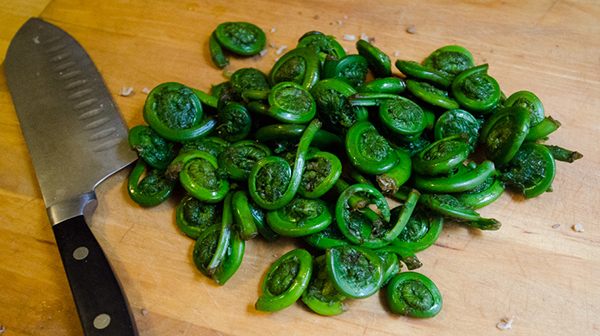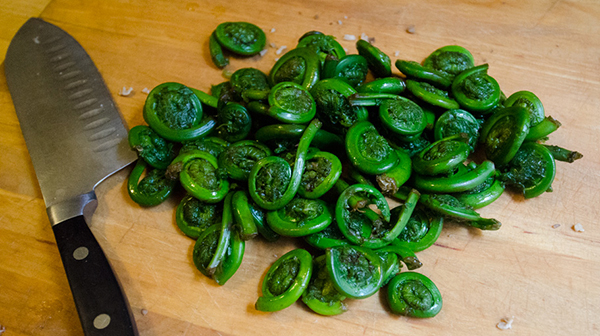
Curled fern tips are tender and mild, with a taste similar to asparagus.
Food is our medicine. Foods not only provide nourishment for our body, they also nourish us emotionally and spiritually. Whether it be root foraging, harvesting wild fruits and nuts, procuring plant fibers for basket weaving, fishing, hunting, or gardening, these practices bond our spirit with the earth and make us feel whole. These practices also keep us connected as families by continuing traditions imperative for our health, livelihoods, and cultural survival.
Our knowledge of edible wild foods, known as First Foods, is passed from generation to generation by our elders. Our inherited knowledge of how to access, prepare and cultivate food ultimately offers us security and peace of mind during times when everything else may feel uncertain.
All communities can take part in connecting to the natural world. We can implement policies that protect First Foods habitats from environmental degradation. Many of us do not realize that the areas around us were once home to a wide array of foods, medicines, and fibers that, when properly stewarded, can continue to play their important role for traditional uses.
Foraging for wild food is a great way to connect with your land and also support your health with diversity of nutrients. There is an abundance of resources to nourish you right outside your backdoor, if you know what to look for.
For example, the highly valued blue camas were essential to nourish many Western Tribes and First Nations. From the Northern California coast to Yellowstone National Park, many Indigenous people have relied on nutrition from these plants to live healthy lives.
Here are four First Foods of the Northwest that we are looking out for this month and why we consider them special.
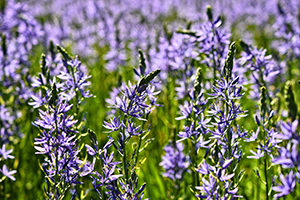 Camas
Camas
Camassia leichtlinii
Here in the Willamette Valley, we have an abundance of edible blue camas blooming April-May. The edible part of camas is the bulb,, which is the part of the plant that is most relished since they are packed with protein and become very sweet when cooked. Camas bulbs were collected by many Northwest Coast tribes. Camas was, and continues to be, one of the most important "root" crops of western First Foods. These plants are adapted to a wide range of terrains: from seasonally wet soils in full sun to partial shade areas from southwestern British Columbia to Montana, and south to California and from east to western Yellowstone and the Rocky Mountains.
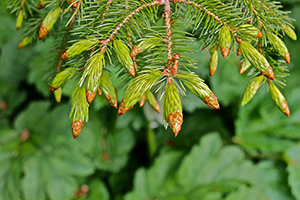 Spruce Tips
Spruce Tips
Picea sitchensis
Native Americans have long known the nutritional value of these young conifer tips. Coastal people used spruce tips, along with other fir needles to brew teas, season dishes, and to cure salmon before smoking it. Spruce tips are packed with Vitamin C and electrolytes, including magnesium and potassium. Many Western Tribes have relied on spring Spruce tips to ward off thirst, hunger, colds, coughs and fatigue.
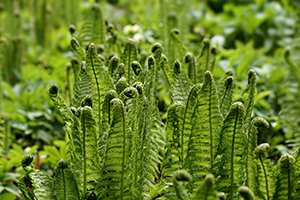 Fiddlehead Ferns
Fiddlehead Ferns
Various species
Fiddleheads are young edible fern fronds that can be harvested from forest floors throughout the Pacific Northwest in mid to late spring. Bracken fern (Pteridium aquilinum), and lady fern (Athyrium filix-femina) are the two edible fiddlehead species in the Pacific Northwest. It is best to harvest the fiddlehead tips as they are emerging from the soil before the tip is unfurled into a leaf.
The curled fern tips are tender and mild with a taste similar to asparagus. Fiddleheads should always be cooked and may be boiled, sauteed, or baked. They can also be processed and preserved in pickling solution, frozen, or canned. Many Native Americans also harvested fiddlehead rhizomes for starch in their diets.
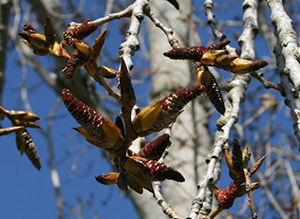 Black Cottonwood
Black Cottonwood
Populus trichocarpa
“Populus'' means “peoples” in Latin to signify how this tree has been so useful for many people over the centuries. Black Cottonwood seeds cannot survive in the shade of their parents and so they must seek new habitat by wind dispersal. These are masses of white-fluffs that take to the skies, usually in late May. The Cottonwood tree was, and still is, viewed as a medicine tree by many Plains Tribes and Coastal Tribes since many parts of the cottonwood tree are medicinal. The buds, leaves and bark are full of a chemical called salacin, which is a natural anti-inflammatory and pain-reducer and has often been applied topically to reduce swelling in wounds. The resin that fills the buds in the first part of the year is also a valuable substance that was used to waterproof baskets and buckets for storing and carrying food, among other traditional uses.
This is only a small sample of the rich and highly varied First Foods and medicine culture that have been stewarded for centuries. This knowledge is shared to enrich the lives of people around the world today. It is up to us, all in our various social, cultural and political roles, to protect and care for these important resources for future generations. Beyond Toxics is committed to protecting the knowledge of and equal access to First Foods and precious natural resources through pesticide reform, community education and promoting stewardship of natural resources throughout Oregon.
~ Jennifer Eisele, Western Shoshone and Northern Paiute and Krystal Abrams, Cherokee & Muscogee.
12 First Foods & Medicines of the Willamette Valley
Camas: Camassia leichtlinii and Camassia quamash Cooking Blue Camas
Elderberry: Sambucus cerulea Delicious Uses for Elderberry
Spruce Tips: Picea sitchensis Foraging Spruce Tips (and other conifer tips)
Dandelion: Dandelion - A foraging guide to its food, medicine and other uses
Tarweed: Madea elegans Late season bloomer: Common tarweed (Madia elegans)
Lomatium: Lomatium dissectum The Supernatural power of Lomatium
Plantain: Plantago lanceolata Three Easy Ways to Cook Plantain, The Spinach-like Survival Weed
Chickweed: Stellaria media The Glories of Chickweed, Uses, Cultivation, Recipes & More
Red Cedar: Thuja plicata Wild Foods and Medicines: Western Red Cedar
Salmonberry: Rubus spectabilis Salmonberry: Food, Medicine, Culture, Part 1
Salal: Gaultheria shallon: Oregon Encyclopedia: Salal
Black Cottonwood: Populus trichocarpa How to Make Cottonwood Salve
